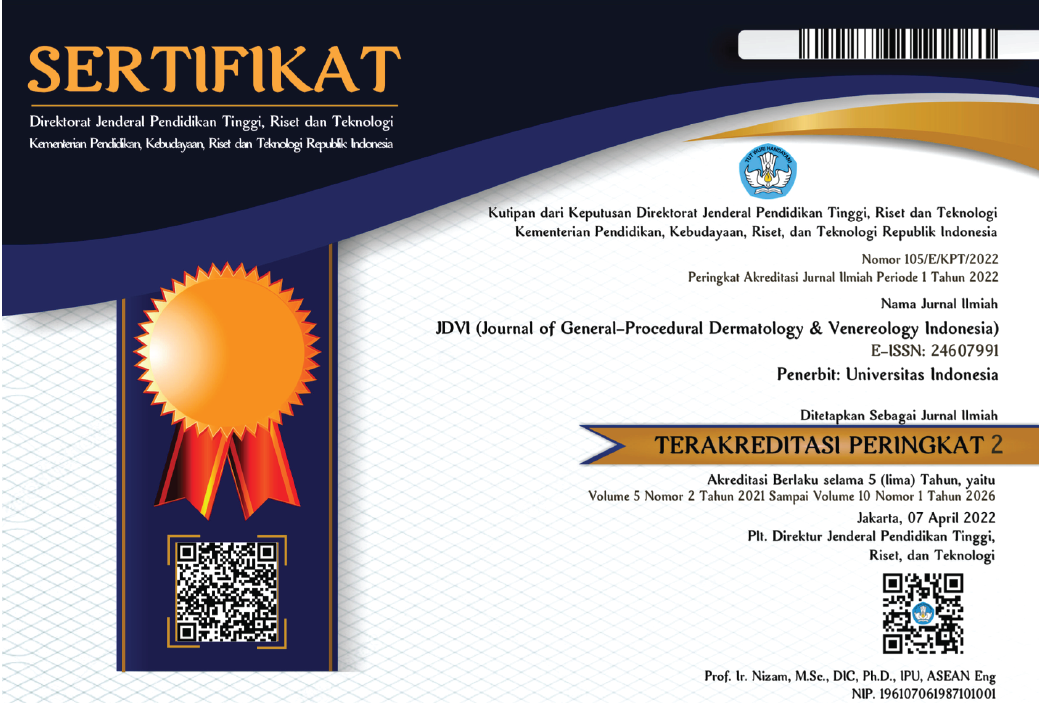Abstract
Background: The clinical manifestation of Darier-White disease, an autosomal dominant genodermatosis, are greasy hyperkeratotic papules in seborrheic regions with nail abnormalities and mucous membrane changes due to a defective sarcoendoplasmic calcium pump. The clinical appearance and unpleasant odor in some sites of the lesions may cause psychosocial disturbances and pose a major morbidity.
Case Illustration: We report a case of a 20-year old female with clinical manifestations of multiple erythematous to hyperpigmented hyperkeratotic papules, multiple flesh-colored keratotic papules with red and white longitudinal bands on dystrophic fingernails, as well as plantar pits. Skin punch biopsy was performed to support the diagnosis. Urea-containing emollients and acitretin at a dose of 0.3 mg/kg/day were prescribed for the patient.
Discussion: Our case showed the classic clinical manifestations of Darier’s Disease. The skin punch biopsy result is also consistent with Darier’s disease. We provided the patient with emollients and acitretin, a systemic retinoid, which are found to be the most effective treatment for DD. While no relationship is established between Darier’s disease and other medical problems, the patient developed anxiety and social isolation due to the clinical appearance and odor, creating a negative impact on her quality of life.
Background: The clinical manifestation of Darier-White disease, an autosomal dominant genodermatosis, are greasy hyperkeratotic papules in seborrheic regions with nail abnormalities and mucous membrane changes due to a defective sarcoendoplasmic calcium pump. The clinical appearance and unpleasant odor in some sites of the lesions may cause psychosocial disturbances and pose a major morbidity.
Case Illustration: We report a case of a 20-year old female with clinical manifestations of multiple erythematous to hyperpigmented hyperkeratotic papules, multiple flesh-colored keratotic papules with red and white longitudinal bands on dystrophic fingernails, as well as plantar pits. Skin punch biopsy was performed to support the diagnosis. Urea-containing emollients and acitretin at a dose of 0.3 mg/kg/day were prescribed for the patient.
Discussion: Our case showed the classic clinical manifestations of Darier’s Disease. The skin punch biopsy result is also consistent with Darier’s disease. We provided the patient with emollients and acitretin, a systemic retinoid, which are found to be the most effective treatment for DD. While no relationship is established between Darier’s disease and other medical problems, the patient developed anxiety and social isolation due to the clinical appearance and odor, creating a negative impact on her quality of life.
Conclusion: Comprehensive and holistic management should be the goals for the management of this rare genetic disorder
Recommended Citation
Chia, Cara Lynn Marie N.; Gabriel, Ma. Teresita G.; Senador, Leilani R.; and Cruz, Ciara Mae dela
(2018)
"Darier-White disease: A rare genetic disorder,"
Journal of General - Procedural Dermatology and Venereology Indonesia: Vol. 2:
Iss.
3, Article 1.
DOI: 10.19100/jdvi.v2i3.58
Available at:
https://scholarhub.ui.ac.id/jdvi/vol2/iss3/1
Included in
Dermatology Commons, Integumentary System Commons, Skin and Connective Tissue Diseases Commons






























